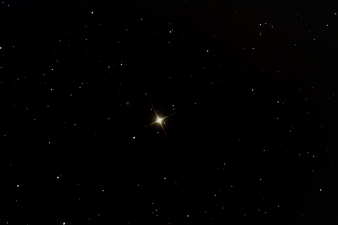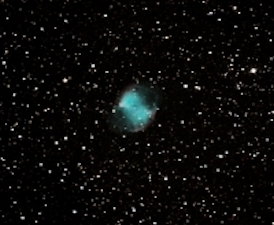

Supernovae From Degenerate Stars
Some of the stars that helped create the materials of which we are made did not end their existence as a Type II or core collapse supernovas.
Once a star burns all of the hydrogen in its core to helium, it evolves off the main sequence to become a red giant. This phase is made possible by the fact that adding a proton to a helium atom makes lithium 5 which has a half life of about 400 x 10-24 seconds before decaying back to a helium nucleus and a proton again. When two helium nuclei fuse to become Beryllium 8 it lasts for about 7 x 10-17 seconds before decaying to two helium nuclei. In order for helium to fuse to carbon, a Beryllium nucleus must fuse to a helium nucleus before it decays and that doesn't happen until the core temperature reaches 100 million degrees Kelvin. The core of our sun is only 16 million K. So helium fusion, or the triple alpha process, doesn't start until hydrogen stops fusing and the core is greatly compressed.
But a ring of hydrogen begins fusing outside the dead core causing the star to expand and so the surface cools and reddens. The greater diameter means an increase in luminosity in spite of cooling, sometimes by a factor of more than 1000. Eventually the core becomes hot enough to fuse helium to carbon and oxygen. Stars that were born at less than 8 solar masses never get hot enough to fuse carbon to neon, and eject their outer layers in the end leaving a degenerate core -- a white dwarf. For the first few thousand years the ejected shell may be lit up by the extremely hot white dwarf, resulting in a planetary nebula.


Mirach in Andromeda is a M0III Red Giant -- photo Rick Whitten M27 the Dumbbell Nebula in Vulpecula. A planetary nebula -- photo Rick Whitten
White dwarfs are no longer stars if the definition of a star includes producing energy by fusion. Instead, white dwarfs are supported by degeneracy pressure. The Pauli exclusion principle, which applies to all fermions like electrons and protons, says that no two fermions can occupy the same space and have the same energy level. So gravity forces a white dwarf's material into a compressed space which means the electrons must jump to higher and higher energy levels. A solar mass is compressed into a space smaller than Earth.
| Historical Naked Eye Supernovas | |||
| Supernova-Year | Type | Apparent Magnitude | Distance (LY) |
|---|---|---|---|
| SN386 | II | +1.5 | 14,700 |
| SN393 | ? | 0 | 34,000 |
| SN 1006 | Ia | –7.5 | 7,200 |
| SN 1054 - Crab Nebula | II | –6 | 6,500 |
| SN 1181 | ? | 0 | 8,500 |
| SN 1572 - Tycho's Nova | Ia | –4.0 | 8,000 |
| SN 1604 -- Kepler's Star | Ia | –3 | 14,000 |
| Cas A - 1680 | II | +5 | 9,000 |
| SN 1987A | II | +2.9 | 168,000 |
White dwarfs are limited to a mass of 1.44 solar masses -- the Chandrasekhar limit. A large percentage of stars are part of multiple stars systems. If two stars are of slightly different masses, one could be in its red giant phase after the other has become a white dwarf. If the pair are orbiting closely, the white dwarf may accrete gas from its partner. Added mass causes the white dwarf to shrink, due to degeneracy, instead of expanding per the usual gas-pressure-temperatures laws. So adding mass heats the star and if the white dwarf is a carbon-oxygen dwarf it may get hot enough to fuse carbon -- all at once. It becomes a type Ia supernova. These are brighter (though less energetic when including the neutrino flash) than Type II supernovas. Type Ia supernovas flare to about 5 billion times the luminosity of the sun.
| Class | Temperature | Color | Mass | Life Time | Fraction |
|---|---|---|---|---|---|
| O | >33,000 K | blue | 16 M | 10 million yrs | 0.00003% |
| B | 10,000 K | blue white | 2.1–16 M | 400 million yrs | 0.13% |
| A | 7,500 K | white to blue white | 1.4–2.1 M | 2.5 billion yrs | 0.6% |
| F | 6,000 K | white | 1.04–1.4 M | 6 billion yrs | 3% |
| G | 5,200 K | yellowish white | 0.8–1.04 M | 12 billion yrs | 7.6% |
| K | 3,700 K | yellow orange | 0.45–0.8 M | 32 billion yrs | 12.1% |
| M | 2,000 K | orange red | 0.45 M | 70 billion yrs | 76.5% |
From our star classification table we see that only O, B, A, and F stars in the Milky Way's disk have had time to evolve off of the main sequence. O class stars are likely to become Type II supernovas. B, A, and F stars are likely to become red giants and then white dwarfs. Less than 3% of the disk's star population has had time to become white dwarfs. Billions of years from now we should expect an exponential increase in the white dwarf population, and thus the Type Ia supernova incidence.